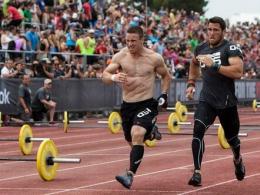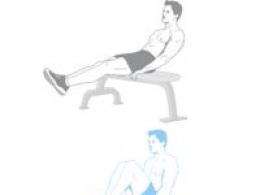Running and gaining muscle mass. How to combine strength training with running Strength training when you can't run
The treadmill does not necessarily have to be the highlight of the program; it may well be an addition to basic strength training.
What is the best way to combine the two types of load? In what order should I alternate them?
To begin with, let's remember the fundamental differences between exercises on the treadmill and, say, on the butterfly.
Cardio ensures the development of endurance (by training the cardiovascular and respiratory systems), and at the same time helps burn fat deposits.
Strength training helps strengthen muscles, but also significantly contributes to weight loss - it accelerates anabolic processes for a long time.
It is important to consider several points:
- Excessively long non-interval runs stimulate catabolism, slowing down the growth of muscle tissue;
- pumping up muscles while running is possible (in particular, due to sprints), but only with the correct movement technique;
- In any case, losing weight through cardio alone is unacceptable - nutritional correction must be put at the forefront.
Jogging at the very beginning
Professional athletes and experienced bodybuilders, as a rule, do not run before strength training.
People who already have good physical shape and exercise to maintain it (for example, military personnel, security officials, etc.) usually prefer to start jogging.
Beginners should only get on the treadmill immediately upon arriving at the gym for a couple of minutes - for a warm-up run at a slow pace. A too active start will quickly exhaust a beginner. At the very first strength exercise, spots will appear before his eyes.
Treadmill after workout
The “cardio after strength training” option is much more universal.
It is justified, if only because when performing strength exercises, it is possible to use up glycogen reserves - while running, the body immediately has to use up long-term fat reserves.
Concluding the article, we emphasize that some athletes prefer not to mix cardio training with strength training, but to perform them on different days.
This method has significant advantages: anabolic and catabolic processes do not overlap each other, the muscles have time to recover.
Additional strength training is especially useful for people who started running in adulthood and have not previously led an active lifestyle. Regular strength training helps eliminate the imbalances that arise in the muscles due to the monotonous load of running and works on weak points.
Running training develops the cardiovascular system, the heart does more work with less effort, and blood flows through the veins faster, which means that the muscles are better supplied with oxygen and the efficiency of the workout increases. Strength training builds muscles and makes us stronger. Runners add them to their training plans to get stronger. Weightlifters run to build endurance and to get lean, as running helps them lose belly fat.
In order for strength training not to tire you, but, on the contrary, to complement and make us stronger, you need to draw up a training plan correctly. The latest research from Australia suggests a workout schedule that will make you stronger and faster.
During the experiment, 15 runners with a very wide range of weekly mileage performed additional strength training in three options:
- one high-intensity full-body workout;
- one high-intensity workout for legs only;
- One low-intensity full-body workout.
Six hours after each workout, they took a treadmill test: 10 minutes of running at an easy warm-up pace (70% of VTOL), then another 10 minutes at a moderate pace (90% of VTOL) and then as long as they could at a power of 110% of threshold pace. The same test was carried out before the start of the study to determine the participants' capabilities while they were not yet tired. The results were considered reference, that is, the data obtained during the experiment were compared with this very first test.
A high-intensity, full-body workout had the effect of slowing down the runner's pace during the very last stretch of the running test, when they were required to run at their maximum level. The average benchmark results are five minutes at 110 percent power. After each of the high-intensity strength training sessions, the time decreased by almost one minute. That is, the runners' ability to maintain a high pace after such training was significantly reduced.
Dr Kenji Doma, senior research scientist at James Cook University, believes these tests can provide practical advice on combining strength training with running to help runners achieve optimal results in their training.
Firstly, and this is obvious, Doma advises not to plan serious races within 24 hours after strength training. The minimum break time, according to the data obtained during the study, is six hours.
Secondly, strength training does not have a negative effect on running at an average pace. That is, you can safely combine strength training with your standard runs at a medium pace. On the days of such training, it is advisable to arrange your schedule so that you run first, and then strength training. The ideal option is to run in the morning, and in the evening do strength training for the lower body or moderate-intensity strength training.
Knowing all this, you can create an optimal training plan. Many trainers recommend alternating hard and light workouts.
What types of training do you prefer? Have you ever thought that the ingrained stereotype of running training is not for “strongmen” is just a myth? But in order for these two types of training to have an effect, you just need to combine them correctly.
Running training should be alternated with strength training, especially for those who started training at a conscious age. This type of load can eliminate the disadvantages of strength training - it uses muscle groups that do not “work” when running.
Great work of the cardiovascular system with minimal effort, which only increases the efficiency of training - the result of constant running loads. Why does this happen? Strength training is aimed at “building” the body (muscles), and running is aimed at increasing endurance. A huge plus of the above-mentioned type is that it has a beneficial effect on weight loss. Weightlifters note that running reduces the number of centimeters in the waist. If you have just begun to develop as an athlete, during the “drying” period, it will be simply irreplaceable.
A properly designed training schedule is the key to the success of combining two seemingly completely different types of training. These words are confirmed by a recent experiment in Australia, which only confirmed the conclusions that this training tandem gives obvious results.
The experimental group consisted of 15 people who were professional runners, who also included strength training in their daily exercise schedule. General high-intensity, aimed at training the legs, and low-intensity general training are categories into which additional loads have been divided.
All study participants were measured 5-6 hours after training. The following conclusions were drawn:
— you should not plan important races earlier than 24 hours after strength training. Adequate break time should be at least 24 hours;
— strength training done at a moderate pace will not affect the quality of running;
— it is better to distribute time in such a way that running occurs in the first half of the day, and strength training, of medium intensity, or on the lower body, in the second.
Running is contraindicated if your workouts are aimed at gaining muscle mass. The process of muscle growth requires a balance between stress and rest, and this is only possible if running in moderation and without acceleration.
Just remember that in your training calendar you need to include the time/days in which the body will be in a state of “rest”. Training and rest should also be balanced, as, in fact, the process of consumed and expended calories.
The positive dynamics of the final results noted by athletes gives every reason to say that spending time on a treadmill, with the correct formation of a schedule, only contributes to achieving success.
Running is the best way to burn fat, given to man by nature itself. Running nose to nose, lagging behind only to the bare minimum, is physical anaerobic exercise. This post will focus on running after strength training.
To avoid any misunderstanding, you need to immediately define what strength training is. Strength training is a workout whose goal is to increase the performance of one repetition with a maximum weight load. An increase in strength indicators is inherent in certain sports: weightlifting, bodybuilding, powerlifting, etc.
Strength training is designed to sculpt a strong, beautiful body, and the body will only benefit if cardio elements are added to anaerobic exercises
Should you run after strength training?
If the goal is to get rid of excess fat deposits or, as people say, during the “drying” period, then cardio training is an effective remedy. As a rule, running after strength training is practiced during this period.
Will running interfere with weight gain? Why is it better to run after strength training?
It is preferable to do cardio training after strength exercises, because otherwise the body will get tired, and strength training will be covered with a copper basin.
Argument 1. As a result of cardio load, the muscles will be forced to use up glycogen, and therefore energy, which will be catastrophically lacking during strength training. There will be a release of cortisol, a hormone that extracts energy directly from muscle tissue, destroying it. The result of such strength training is a decrease in muscle mass.
Argument 2. Here is another argument in favor of “after”: since the muscles after strength training exhaust their entire glycogen supply, the body begins to pump out fat reserves from the very beginning of the cardio session. That is, running after strength training also has a significant fat-burning effect. Also, the advantages of jogging “after” include the ability to consolidate the results of weight exercises.
What are the disadvantages of running after strength training?
The disadvantages include the fact that jogging can significantly slow down the growth of muscle mass if you are an ectomorph or a transitional type between ectomorph and mesomorph (that is, thin build with a relatively small percentage of subcutaneous fat).
In addition, there is still a possibility of a negative impact on the recovery process if the intensity is incorrectly selected.

Incorrectly selected load during the jogging phase can slow down the process of restoring the body's resources due to exaggerated running intensity
Here we naturally move on to the next question.
When using the “strength training - jogging” combination, you need to be extremely careful. An incorrectly selected load during the jogging phase can significantly slow down the body’s recovery resources due to the exaggerated intensity of running, or may not give the desired result due to insufficient load.
Duration and intensity of cardio training after strength training
The intensity of the cardio session should be within the aerobic zone at a heart rate of 140-150 (this is the level at which the ability to maintain a conversation with a prospective partner should not be lost while running).
In terms of duration - focus on long-term loads of at least 30-40 minutes of continuous running. This regimen will ensure that you burn a fair amount of calories in addition to your strength training, while also burning some of your body fat.
Interval running for fat burning
You can try to realize the opportunity to spur fat-burning processes in the body, and through this speed up metabolism, with the help of interval running. Interval running is an alternation of intense and calm jogging paces. This method is definitely a shake-up for the body, which will result in even greater weight loss. But the risk of overtraining with this approach increases significantly, since the body may not recover until the next workout if the load is calculated incorrectly and turns out to be excessive.
Rowing and skiing.
The effectiveness of strength training is also that it is excellent, which makes the runner lighter, and therefore gives him an advantage. In addition, a strength training program reduces the likelihood of getting any running injury. Strength exercises for runners also help stabilize insulin sensitivity and increase antioxidant status, which any professional runner cannot do without.
At the same time, if you are already doing a strength training program, but the results are not so noticeable for you, you may be doing it incorrectly. Most likely, your training plan is designed with some flaws, which slows down your growth. But is it even worth doing them while jogging, and if so, is it possible to combine running and strength training? This question worries the minds of many athletes, both runners and athletes. After all, everyone wants to get the most out of their sports activities, at the same time, so that they are at the same level and their endurance indicators do not let them down.

With this article, we will talk about how to combine running and strength training or so that they interact and are only beneficial, and also look at the reasons why bodybuilders and runners speak out against such a combination.
Why bodybuilders don't want to combine strength training with running


- The main goal of many non-professional runners is. It’s not for nothing that it is believed that this is the basis for cardio exercises. However, working out in the gym with exercise machines also seriously loads the heart, which, of course, strengthens it well. Therefore, it can be considered an effective alternative to cross-country.
- Strength training increases production of anabolic hormones, which stimulates muscle growth. On the other hand, after strength training it leads to inhibition of this process. It is for this reason that those who are engaged have a certain body build, thanks to which their occupation becomes obvious to everyone. This means that if you want to acquire large muscles, you should discard the option of running.
- And although running and strength exercises differ in how much (in the first case it is more wasteful), adherents of weight training note the fact that even after completing a strength session, the muscles continue to receive an energy charge from fat reserves, which allows them recover and grow faster. So, at the end of the workout, the athlete will not gain weight, but on the contrary, everything he ate will be used to restore and increase muscle material.
- Running before strength training will lead to a large depletion of energy reserves, and this will affect how well you perform in your gym sessions. If you run after weight training, then your body will immediately begin to take care of its lost energy reserves, and only then will it move on to building muscle.

Why runners don't want to combine strength training with running
- Jogging brings significant benefits to the heart, as it is gentle on the human body, and the load can be easily reduced or increased based on personal feelings. At the same time, with this and greater weight, it is more difficult to exercise self-control of your body. Therefore, strength training has a stronger negative effect on the heart and blood vessels. Based on this, we can say that going out only for jogging will be healthier for your cardiovascular system.
- Have you ever noticed that, most often, they are distinguished by their athletic physique and muscles, which are the envy of many athletes? This is due to the fact that short-distance running, identical to strength methods, uses precisely the muscle fibers that are most capable of growing when receiving certain loads. And if you also take into account that when running there will be, then you will definitely get a comprehensive growth of your muscles as a final result.
- When running, a huge amount of energy is consumed and more than during strength training. Jogging consumes several times more calories than when working muscles in the gym. Also, after 30 minutes, the body begins to burn fat reserves as the liver and muscles begin to lose glycogen. This means that running will help you lose excess from the body.
- You won’t be able to go for a full run after doing a strength program, unless you can run to cool down after a workout. So many people choose - or the gym.

Combining running and bodybuilding
In order to properly combine running and strength training, you should distribute them on different days of the week. That is, you need to choose those days when you jog and those when you lift weights.
On those days when strength training is planned, you can go for a run, but only for no more than 1 km.
On jogging days, it is better to do workouts for no more than half an hour, so that fast and slow muscle fibers did not conflict with each other.
Once a week or more, if your strength allows, you can exercise, which differs in its intensity.
When you are actively working on increasing your mass, the loads of the running plan should be significantly reduced, and vice versa, if the goal is, then you need to run more often and longer.

So, strength training in running plays an important role, however, it is not always necessary. So to use it correctly, you need to carefully and competently combine them. This approach will provide an opportunity to get benefits from both of these sports.
Video. Is it possible to run after strength training?






